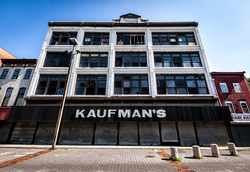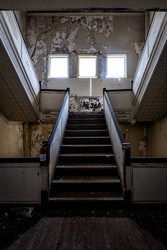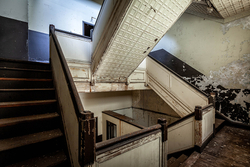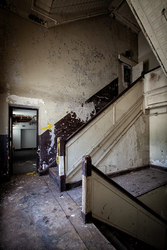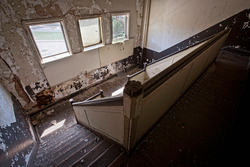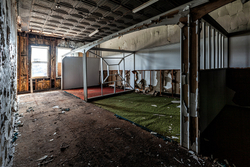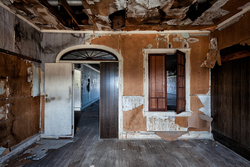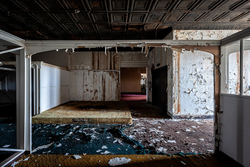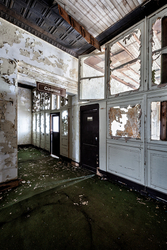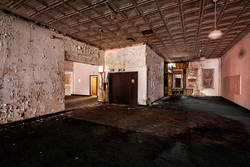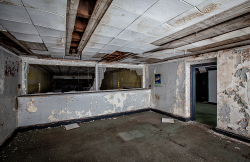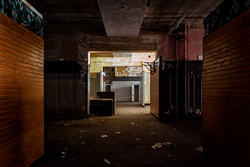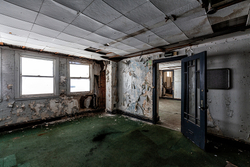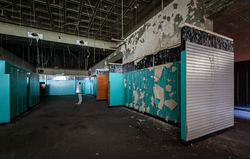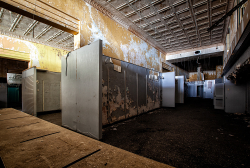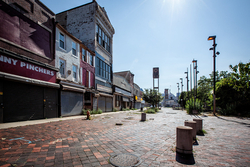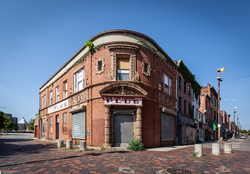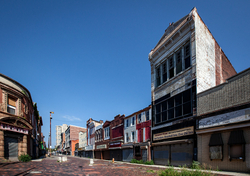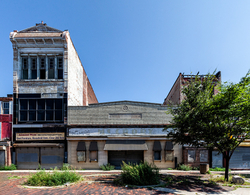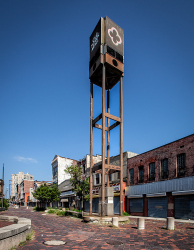Kaufmans Department Store
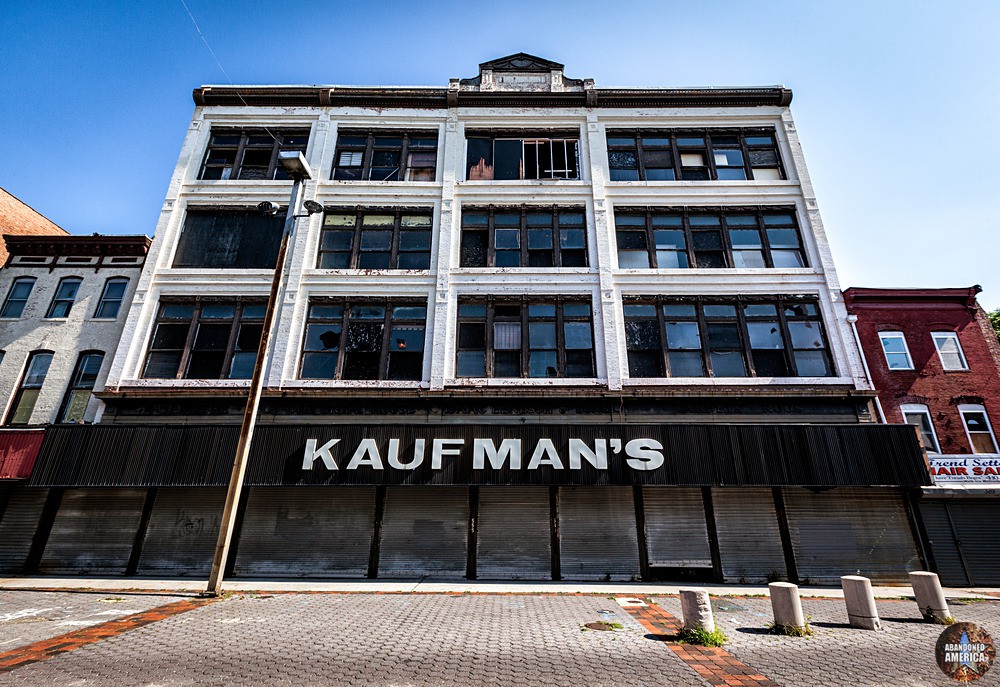
The facade of the formerly abandoned Kaufman's Department Store in Baltimore, MD
Updated September 23, 2022 | By Matthew Christopher
Looking at the Old Town Mall in Baltimore today, you’d have no idea it was one of Baltimore’s most important and historic commercial districts. Nearly all of the stores are vacant and dilapidated, and it has the atmosphere of a place that is entirely forgotten. Located roughly in the center of it is the former Kaufman’s Department Store, which closed in 1997. It’s a beautiful four-story building, with the name of the store proudly displayed in bold white letters over the steel shutters. Currently Kaufman’s is the home of the Nevermore Haunt, who bought it in 2014 and have been using it as a haunted house attraction that centers on the city of Baltimore’s dark history. It’s a matter of opinion, of course, but it does seem fitting to use one of the city’s most neglected areas to explore the horrors of its past.
Currently, Baltimore is comprised of three original towns – Baltimore Town, Fell’s Point, and Jonestown. Jonestown is located in the southeast of the city, and is considered the oldest and most historic of the three. It’s named for the settler David Jones, who built a house on the east side of a stream running into the Inner Harbor in 1661. Jonestown was founded in 1732, and as a central access to the point for the city of Baltimore it became a locus for commerce and industry and a home to Jewish and German immigrants and free African Americans. After it was incorporated into Baltimore in 1745 it was called Old Town or Oldtown, and the construction of the Bel Air Market in 1818 boosted business in the area. In the years following the Civil War, Gay Street in Oldtown (named for surveyor Nicholas Ruxton Gay) was home to many banks, insurance companies, and businesses.
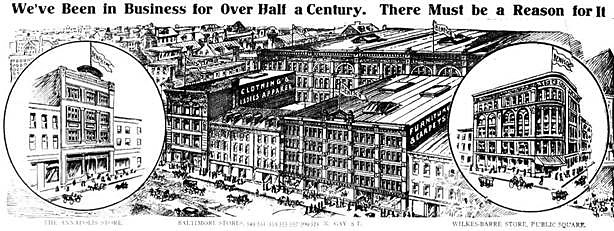
A 1910 advertisement for the Great House of Isaac Benesch and Sons
Isaac Benesch, a furniture salesman who would construct the building that later became Kaufman’s, moved his business to Gay Street in the 1860s. Benesch was an immigrant from Bohemia and opened his first store at 17. He purchased neighboring rowhomes on Gay Street as his businesses expanded and in 1882 he demolished the row homes and built a four story building which would become one of Baltimore’s most prominent department stores. By the late 1890s it was known as the Great House of Isaac Benesch and Sons, and in addition to furniture, it sold clothing, silverware, jewelry, hats, and more.
One of the most notable aspects of the Great House’s history is that it was, unlike many stores at the time, it proudly served Black customers. In a period where many department stores either outright refused entry to Black patrons or offered them predatory deals, Benesch went out of his way to ensure that Black customers would be treated equally and fairly. In 1898, an article mentioned “Isaac Benesch & Sons very much appreciate the large volume of colored trade which they have, coming from all parts of the city”, and another ad in 1900 proudly proclaimed that the Great House was “Baltimore’s Most Progressive Furniture, Carpet, and Clothing Stores”. Benesch’s sons Samuel, William, and Aaron took over when Isaac passed away in 1910, and continued his legacy.
The African American population of Oldtown was growing, as laws in the city in the 1910s increasingly restricted where they could live. The Great House hired a Black tire salesman named Josh Mitchell in 1926 and featured him in their advertisements. During a city-wide campaign in the 1940s to desegregate department stores and theaters, the Benesch family not only offered support but assisted in negotiations. By the time laws were passed in the 1960s prohibiting discrimination in department stores, the Great House’s heyday had ended, and the building was leased out in 1963 and soon became Kaufman’s Department Store.
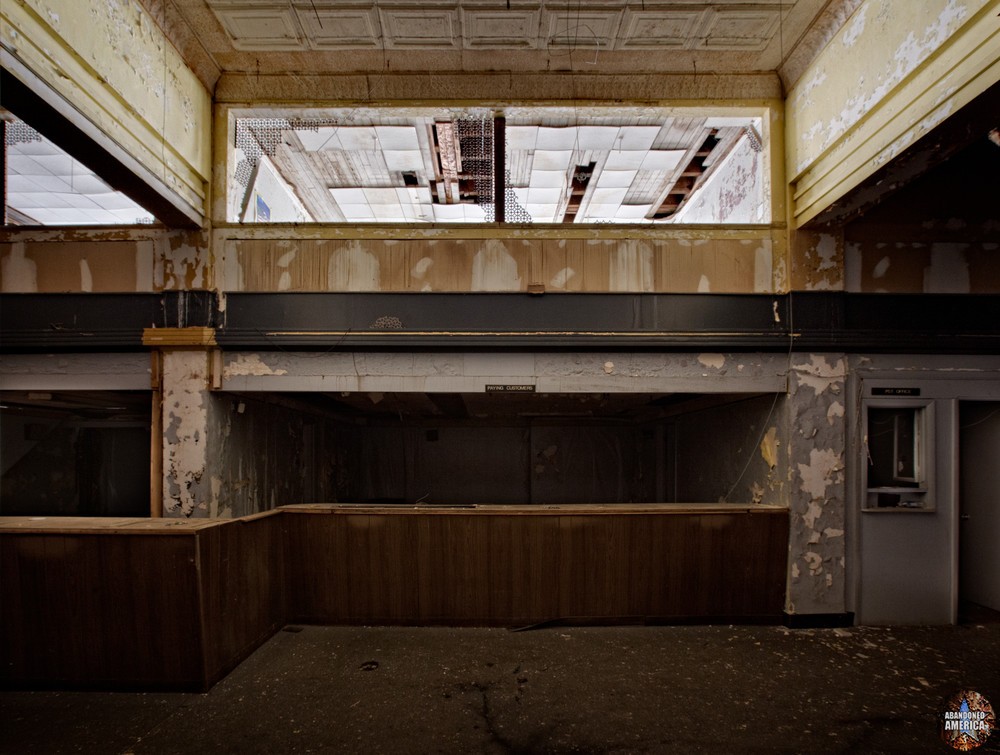
A customer service desk on the first floor is shrouded in darkness, with the only light coming from the mezzanine above.
Details about the origins of Kaufman’s Department Store are hard to come by. The 1997 obituary of Gerald Jeffein, son of one of the co-founders and primary owner until the store closed, mentions that Kaufman’s was founded in 1923 and Jeffein took over in 1966. As there were several locations, one could assume that 1966 was the year Kaufman’s opened in former Great House building, but concrete details are scarce and often overshadowed by the history of the much larger and better-known Kaufmann’s Department Store in Pittsburgh. What is clear is that Old Town had become one of the poorest neighborhoods in the city as a result of financial divestment and white flight to the suburbs in the 1940s. In addition, the Jones Falls Expressway and US-40 cut off the area from the downtown and isolated it, and the construction of housing projects furthered the segregation from the city. Shops struggled to remain open and by 1967 the area was described as dilapidated and dirty. The Baltimore Riot of 1968, which followed the assassination of Dr. Martin Luther King Jr., caused $12 million in property damage and Gay Street stores were devastated.
Following the riots, the city planned to revitalize the area with a $1.7 million (listed also as $2.5 and $3 million in various articles) project to turn the Gay Street corridor into the first inner-city pedestrian mall, known as the Old Town Mall. A fountain and clock tower were built, trees and street lamps were put in place, and the street was repaved with bricks – but despite the success heralded by articles proclaiming “Good things are happening in Old Town”, nothing had been done to address poverty and a lack of jobs in the area. While the mall was considered a model for future urban planning, it was still described as “halfway there” by the Baltimore Sun in 1976.
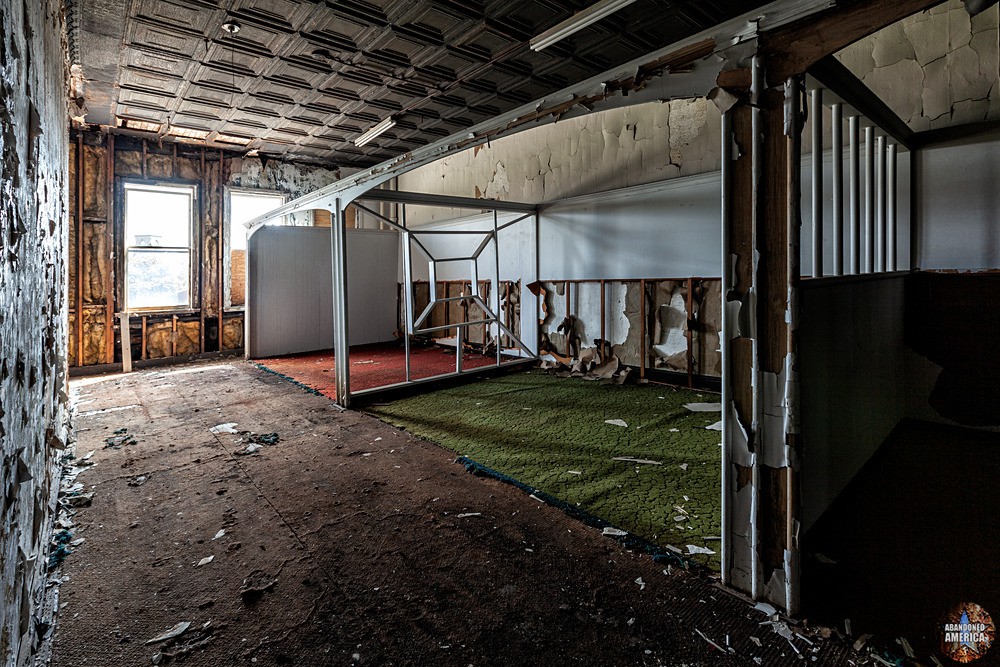
A second floor showroom at Kaufman's Department Store
Unfortunately, a blizzard in February 1979 led to what was described by the Baltimore Sun as a “carnival of looting” in stores across the city. Kaufman’s was hit particularly hard. “In empty show windows, naked and dismembered mannequins lay in a grotesque pile”, the article reported, and added that the entire first floor of Kaufman’s had been emptied of clothing, televisions, and stereos. For store owners who spent the last decade recovering from the riots and had raised $2 million of their own money for the restoration, it was particularly disheartening. Along with the storefronts, the dreams of Old Town Mall as a new shopping destination that would somehow lift the surrounding area out of decades of systematically constructed inequity and violence were shattered.
During the 1980s the area around Old Town Mall continued its descent as poverty and drugs ravaged the area. Code violations weren’t enforced by the city and vacant, rat-infested properties deterred visitors. By the 1990s many stores were abandoned and Gay Street had a sense of isolation and desolation that led many shop owners to question whether the pedestrian mall plan was a mistake. Gerald Jeffein, the owner of Kaufman’s, who had at various times been president of the Old Town Mall Merchants Association, never gave up hope. When he passed away from cancer on March 25, 1997, his obituary fondly described him as the “Don Quixote of Old Town”, and mentioned that a mall renovation project would be complete by the following year. One day prior to his death, Jeffein had quietly filed for bankruptcy.
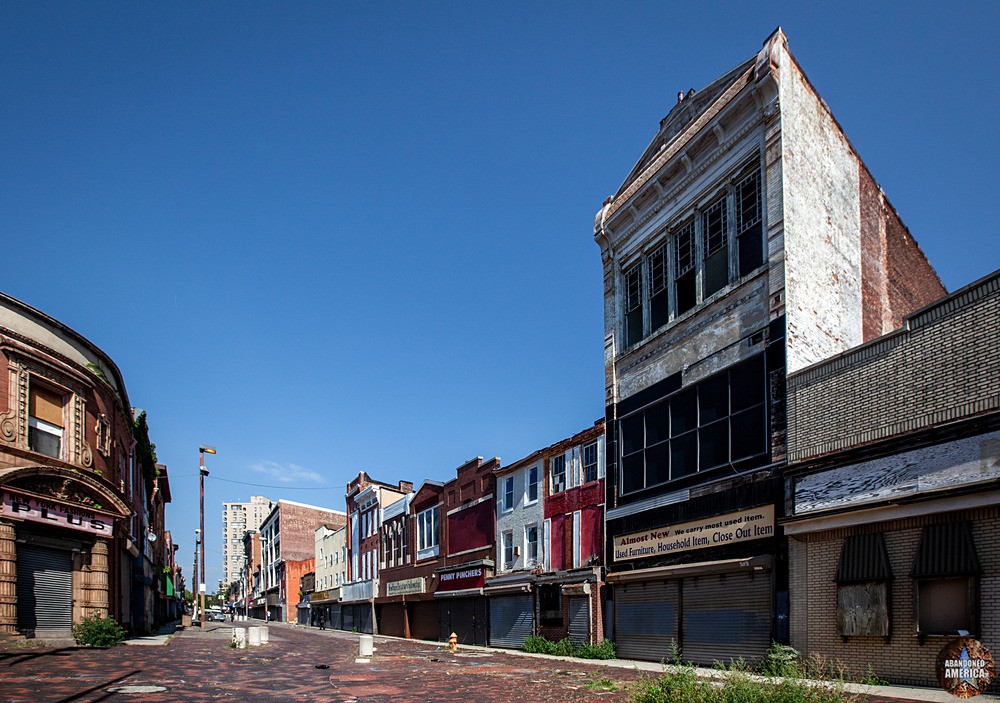
A view of Old Town Mall shows overgrown sidewalks and vacant storefronts
Though the Bel Air Market was demolished in 1997 in hopes of enticing a grocery store to the area, whatever renovations were expected in 1998 never materialized. Another $4.8 million plan was launched by Mayor Martin O’Malley in 2000 that would include a bank and a grocery store, but that too evaporated, as did yet another plan for a Safeway grocery store in 2002. 2010 and 2016 saw more plans for the area that included condos, retail, and community space, but as of 2021 the few businesses remaining in Old Town Mall - including a pawnshop, a tailor, and a barbershop - continue their plea to the mayor for help. In December 2021 it was reported a planned development “could break ground next year”, but with no further news on the subject it seems a safe bet that it has not.
Kaufman’s Department Store, however, is no longer abandoned after it was purchased by Joe Hudson in 2014 for $225,000 to use as the location of the Nevermore Haunt. At the time of the purchase, 28-year old Hudson saw the 40,000 square foot building as both a business opportunity and a way to draw businesses back to the area. I’ll confess that when Joe invited me to the building before any work began in September 2014, I thought the plan – which required $300,000 to renovate the building so it had electricity and a working sprinkler system – was ambitious on a scale that approached madness, and while I appreciated the opportunity to photograph the vacant store, I had serious doubts about the viability of the project.
Joe proved me (and probably quite a few others) wrong, though: currently the website of the Nevermore Haunt is taking reservations for their Fall 2022 season. While I haven’t had the chance to visit it personally the online reviews are generally positive and they won a “Fright of the Year” award in 2021 from FrightTour.com. The also have food and beer vendors serving patrons, and with 7 years under their belt, it’s safe to say the idea has been a success. It certainly hasn’t fixed the area’s problems, but that’s too much to ask of any single business. Having said that, it has provided some much-needed repairs to the Kaufman’s building and served as an example that with hard work and some inspiration, perhaps new businesses can thrive there after all.
👉 Join Abandoned America on Patreon for high quality photos & exclusive content
👉 Make a one-time donation to help keep the project going
👉 Listen to the new Abandoned America podcast
👉 Subscribe to our mailing list for news and updates

